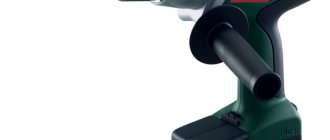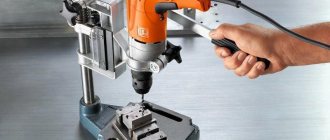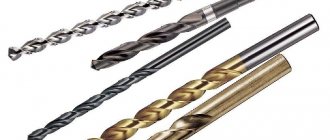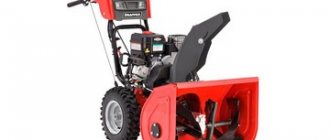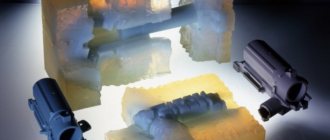A drill is a necessary and widely used household tool. Every person is faced with the moment when he first decided to use it, and first thinks about how to insert the drill into the drill.
Drill device diagram.
Indeed, without resolving the issue, its use is impossible. Solving this problem is not a big problem, but it is better to seek advice when using the tool for the first time. An incorrectly inserted cutting element can cause a lot of unnecessary trouble.
Main functions of the tool
The main purpose of an electric drill is to drill holes in materials. It was for this purpose that Wilhelm Fein invented it in 1895.
Inside the plastic case there are components:
- electric motor;
- starting switch;
- gearbox;
- reverse;
- retainer;
- capacitor;
- impact mechanism.
A chuck for attachments is attached to the shaft (spindle) of the drill using a thread and a fixing screw.
Photo: electric drill
Drill equipment
The fixed drill rotates both to the right and to the left. For this purpose, a reverse switch is placed on the housing. In this mode, you can only remove the drill from the hole or unscrew screws and screws. Turn on for a short period of time at reduced speed.
Drill operating modes
Many had to hammer into the wall with a bolt in order to hang a cornice or a picture. Now this is done with a drill, setting the correct operating mode.
- Unstressed. Carpentry and plumbing work is carried out in this mode.
- Shock. For working with concrete, brick or stone foundations. The rotating drill moves in the longitudinal direction and makes translational (impact) movements.
The speed of the drill differs for different tasks and is adjusted in two ways.
- Mechanical. The desired position is set on the scale. As speed decreases, torque increases. The output power does not change, even under load. You can set the speed while the drill is running.
- Electronic. The speed is controlled by a built-in rheostat. When you lightly press the switch key, the drill rotates at low speed. As you press harder, the speed increases until it reaches the set limit. The extreme value can be limited by a special wheel on the button. The output power with this method is reduced.
Speed modes
Mini mixers do not have gearboxes. Most often, such hand tools can operate in one mode. But powerful units (over 1 kW) have a gearbox. Manufacturers specifically include it in the design to ensure rational use of the electrical device itself. Most often, the gearbox sets two operating modes:
- first gear – low speed and high torque;
- second gear is a reduction in torque as the number of revolutions increases.
The first gear is used for mixing concrete, screed mortars, and so on. That is, for viscous and dense materials. The second is for liquid solutions. But at the same time it is necessary to take into account the temperature regime in the room where repair work is carried out.
As the temperature decreases, the viscosity of many materials increases. Therefore, you will have to take this moment into account in order to choose the right gear transmission.
How to insert a drill into a chuck
Step 1: The chuck jaws are closed.
Closed chuck jaws
Step 2. Rotate the adjustment ring counterclockwise by hand. The jaws inside the chuck diverge to a distance slightly larger than the size of the drill.
Turn the ring counterclockwise by hand
Step 3. Insert the drill into the chuck to the full possible depth. The diameter of the clamped tool is allowed 2 - 13 mm.
Insert the drill between the cams
Step 4. By rotating the adjusting ring clockwise by hand, tighten the drill.
Rotate the adjusting ring clockwise
Step 5. Insert the drill key into the hole on the chuck body so that the teeth on the key and the chuck are closed.
Insert the key into the holes of the cartridge
Step 6. With slight pressure, turn the key clockwise until it stops to securely fix the drill. There are 2 - 3 key holes, we insert them into each one in turn for uniform clamping.
Turn the key clockwise until it stops
Step 7. The drill is ready for use.
View of a drill with a fixed drill bit
Before carrying out any maintenance work, remove the plug from the socket.
To avoid losing the key, craftsmen secure it with electrical tape to the drill wire.
Less commonly used is a quick-release jaw chuck, which is tightened without a key. It comes with one or two adjusting sleeves with anti-slip notches. If there is only one sleeve, hold the drill body motionless. If there are two sleeves, the part fixed to the spindle remains motionless. The moving part is turned by hand: when securing the drill clockwise, when removing it counterclockwise.
Design and features of the toothed chuck
The classic drill chuck is a collet or cam type clamping device. They can hold not only various tools with a round shank, but also cylindrical workpieces for further processing. The main design elements of jaw chucks are:
- cylindrical body;
- an adjusting ring or sleeve rotating on the outer surface of the housing;
- a cam mechanism or collet installed in the inside of the device body.
How to remove a drill from a chuck
The drill can only be removed from a disconnected tool.
While rotating, the drill and chuck become very hot. Do not touch them with bare hands immediately after switching off.
If there are no problems with the drill such as jamming or breakage, it is easy to remove it from the chuck. Proceed in reverse order.
- The key is inserted into the holes of the cartridge one by one and turned slightly counterclockwise. The clenching of the fists weakens.
- The adjusting ring is manually turned counterclockwise. The fists inside diverge.
- Take out the drill.
If the drill has a locking mechanism, first press the locking button.
Troubleshooting
In situations where the seeder is used only for narrowly motivated purposes and at times, users usually send it for repairs at the first dilemmas that arise. But it is almost always enough to be able to get around unusual situations that have arisen. To correct minor problems, you need to know how to change the drill, whether it can be done without a key, and what to do if it gets stuck.
Changing the drill
To carry out this procedure, you first need to get an old drill according to the scheme described a little higher, and then install a new one. Electronic drills with keyless chucks often have difficulties due to the fact that the drill sits firmly and it is impossible to unscrew the clutch. In this case, you can use a piece of fabric that will give more grip to the clutch and try to unscrew it. If this method does not help, then you need to firmly fix the drill with your hand and hit the cartridge tangent to the unwinding with the palm of your other hand, continuing to fix the tool.
How to use a drill: basic rules
Beginning of work
- Before turning on, check the plug and cord. If damaged, do not use the drill. The plug must fit tightly into the socket.
- The side handle (if present) is put on the spindle and secured in any direction. It gives additional control over the instrument.
- The drill is tightly fixed in the drill.
- Set the switch to drilling/drilling mode.
- To limit the depth, set and fix the position of the limiter.
- The regulator sets the maximum speed.
- There are drills with a drill diameter recognition function in the range of 3 - 13 mm. In this case, the automation takes into account the size of the drill and the material being processed. The optimal speed is determined by the autopilot. Automation cannot be used if the drill diameter is larger than the shank. Then the required speed is set manually.
- Press the switch key. If the speed control is electronic, it is changed by smoothly pressing the trigger.
How to make a vertical, horizontal, corner hole in wood
During drilling, the workpiece or part is tightly clamped in a vice on a workbench or with clamps to the work table.
Under no circumstances should you hold the part with your hands; both hands must be free.
Holes with an electric drill in any material are drilled only at an angle of 900.
How to drill a vertical hole
- Put the drill in drilling mode.
- Select speed: the thinner the drill, the higher. The diameters of the drill and the screw shaft must be equal. Otherwise, the screw is difficult to insert and the wood will crack.
- If the hole is through, it is good to place a wooden block under the workpiece. This will prevent the edges of the hole from splitting when the drill comes out.
- If the hole is blind, its diameter and depth should be the same as that of a screw for screwing in. Even if you screw in self-tapping screws, light pre-drilling will make the job easier.
- The drill enters the surface only at a right angle. Having fixed the tip of the drill in the wood, turn on the maximum speed to obtain a smooth edge of the hole. The higher the speed, the more accurately the drill moves and cuts the wood fibers.
Video: how to drill a perpendicular hole using homemade products
For a horizontal hole, only the workpiece is moved. If a hole at an angle is required, the desired position of the part is set in a vice. It is clamped rigidly and skewed so that the drill enters perpendicular to the surface.
Bench vice with spacers
If a hole is needed in a part of a non-standard shape (for example, cylindrical), prepare one or more gaskets. They fix the desired position of the workpiece in a vice and guide the drill (preferably with a centering tip) to the drilling point.
The drill only goes into a flat surface. Professionals use a jig device for drilling at an angle, which is attached to the part.
Jig for drilling holes at an angle
You can make the simplest conductor yourself.
- In a block 50 - 60 mm thick, drill a hole at an angle of 900 with a depth of no more than 5 mm.
- Without removing the drill from the hole, change its direction to the desired angle. Pre-drilling will prevent it from slipping out. Drill the block to its full depth.
- The primitive conductor is ready. The drilled hole will serve as a guide for the drill.
If craftsmen do not want to use conductors, they come up with convenient devices for themselves.
Video: angle drilling device
How to drill holes in concrete and brick foundations
If perpendicular holes are drilled during construction work, a support post will ensure precise direction of the drill. The drilling depth limiter will tell you when to stop. If it is not included with the drill, do it yourself. A wooden cube is “cut” onto the drill that will be used to work. The free area of the drill is equal to the required depth. Or they wrap electrical tape around the drill in front of such a section.
Only a rotary hammer can withstand a long load in shock mode. But for short-term work, a drill is suitable. To do this, set the shock mode and operate at high speeds. It is important to ensure that there are no hidden wiring or fittings in the wall or ceiling.
When drilling such surfaces, a lot of dust and debris gets onto the drill; it needs to be cleaned in a timely manner.
At the end of the work, the cartridge is blown out with a stream of compressed air.
Drills marked “for concrete” with a carbide cutting part will quickly drill through walls or ceilings. It is optimal if they have a hex shank. The maximum drilling diameter in concrete is 16 mm. If the holes are up to 8 mm, it is easy to work with diamond drills.
Video: hole in a concrete wall under the baseboard
https://youtube.com/watch?v=BCuzlkh2JYQ
To drill a large diameter hole (for an electrical outlet), use a ring bit.
When drilling brick, choose carbide drills with pobedit tip. Drill at high speeds in impact mode. It is important that no electrical wiring runs inside the masonry. The drilling site is marked with a center punch, and the tip of the drill is placed in the hole. Drill perpendicularly so as not to break the drill. The process requires gentle pressure on the drill and regular cooling of the drill in cold water.
When using a drill in impact mode, safety glasses are required. They will protect your eyes from dust, pieces of concrete and brick.
How to drill metals
The maximum permissible drill diameter when working with steel is 13 mm.
For steel, choose drills marked “for metal”. If the part is small, secure it in a vice. Use a center punch to determine the drilling location and hit it lightly. A small depression is formed, and the end of the drill is placed into it at a right angle. Drill metal with constant pressure. If the metal is hard, drilling is slow. Soft metal is processed at medium speeds.
The drill is removed from the drilled metal without turning off the drill. It is turned off when it completely comes out of the hole.
When working with metal, wear safety glasses and tight-fitting clothing with long sleeves to avoid harm from sparks and prickly metal shavings.
For stainless steel, use drills marked “for stainless steel”. A simple drill immediately overheats during operation, and the viscous metal melts. For cooling, special compounds based on sulfur and machine oil are used. The drill is set to minimum speed (100–600). If there is no smooth adjustment, drill gradually: start the tool for 1–2 seconds and immediately turn it off.
Video: how to drill metal correctly
After prolonged operation at low speed, the drill is switched to maximum speed. Let it idle for 2-3 minutes to cool down.
For cast iron, use drills “for cast iron” with special sharpening. But they are difficult to find, so they choose carbide drills for metal. Cast iron is a hard material, but if handled carelessly, it splits easily. The selected place is cleared. Drilling begins with a small diameter at low speed, constantly cooling the drill with kerosene or water-based solution. Haste and increased pressure will only do harm.
Excessive pressure damages the instrument. It is better to start drilling with small drill diameters or with less pressure on the drill.
For the channel, you need metal drills from 3.5 mm to the required one in increments of 2–3 mm. The holes for the drill are filled with a center punch. Drill with light pressure, starting with a smaller diameter, gradually drilling out the hole. Drills are constantly lubricated with machine oil. Diamond drill bits are easier to use.
How to make a groove in wood
The workpiece is securely secured in a vice or clamp to avoid twisting and prevent accidents. It is strictly forbidden to hold it in your hands.
You can make a clean, smooth, even groove only with a milling cutter. In the absence of a milling machine, craftsmen attach a cutter from a router with a shank with a diameter of 8 mm into a drill. The spindle speed of the drill is not enough for serious machining. This option is only suitable for rough work.
An attachment for drilling wood will help you make gutters and channels. The six-edge serrated drill drills at high speed. The wood does not split, the surface remains smooth. Drilling takes place in three directions and is successful where simple drills fail.
For small rough grooves, a special drill bit with longitudinal cutting edges and transverse cuts is used.
Video: drill bit in action
https://youtube.com/watch?v=0Pz6aD7n-j8
DIY method
They are used when there are no cutters or such a drill.
Markings are made on the workpiece and a furrow is simply drilled, controlling the depth. If the drill is electronically controlled, start at low speeds. When this function is not available, special wood drills are used. They are spiral, made of high strength steel and have a point for centering. The tip of the drill is fixed in the wood and the maximum speed is turned on.
Jumpers remain between the holes, which are then removed with a chisel and cleaned with sandpaper.
For holes with a diameter of 10–32 mm, ring drills are used.
How to drill tiles
Sometimes you need a hole in a tiled wall. Tiles, tiles and other materials that crack should not be drilled using impact mode. If the hole is small, use a drill for glass and tiles to drill into the ceramic tiles until it stops. Then insert a concrete drill and continue working in hammer drill mode. For a large hole, drill the tile with a diamond-coated core drill, then continue working on the concrete.
Additional recommendations
Using a hammer drill you can mix a variety of substances:
- plaster of all types;
- cement;
- putty;
- tile adhesive.
When performing such work, it is unacceptable to use the impact mode. It is also unacceptable for the mixed liquid to come into contact with equipment. After finishing work, both the hammer drill itself and the mixer must be thoroughly washed and dried at room temperature. This helps extend the life of the device.
If the working part of the device becomes clogged with glue, it is necessary to stop it, disconnect it from the network and wash off the contamination. If you do not do this in a timely manner, you may be afraid of failure.
It is extremely important to ensure that the wires are positioned correctly. Winding them around the rim can result in serious injuries
The hammer drill must be held firmly in your hands and not be distracted by extraneous stimuli.
The number of revolutions is adjusted according to how deeply the whisk is immersed. If you mix at full speed at the very top of the bucket, splashes will inevitably occur. As soon as the kneading is completed, reduce the speed and remove the whisk. Immediately immerse it in a bucket of clean water and run it again for 2-3 seconds to completely clean it. This technique allows you to prepare the tool for work again.
To learn how to choose a mixer, watch the following video.
Why are sparks in a drill dangerous?
An electric drill, like any other power tool, requires systematic maintenance. Spare parts wear out during operation and the lubricant dries out.
Drill brushes require regular replacement. One of the manifestations of the problem is that the electric motor does not work at normal voltage in the network. A bright signal is the formation of a circular fire on the collector. The spectacle is beautiful, but dangerous. In order not to ruin the anchor of the drill, they are changed. It is advisable to buy original ones, not Chinese ones. With them the tool will last much longer.
Please note: brushes are not universal. If you don't know what size you need, take an old one with you as a sample.
Photo: brushes for electric drill
Graphite brushes for drill
The design of the drill allows you to replace the brushes yourself. There are models in which there are installation windows for brushes on the body. Replacement is simple:
- The plugs are unscrewed from the installation windows.
- Remove worn brushes.
- New brushes are installed.
- Screw in the plugs.
Other models require minimal disassembly of the drill:
- Remove all screws on the housing. Remove the cover. It is more convenient to leave the screws in their “native” places.
- Take out the brush holders and remove the worn brushes from them.
- Insert new brushes, pushing the spring firmly into place.
- Insert the brush holders into place, tighten the electrical contact of the supply wire well.
- Close the housing cover and tighten the screws.
Video: how to replace brushes
Nozzles: saving effort and money
If we make a rating of power tools for which manufacturers produce additional attachments and accessories, the electric drill is the leader. The drilling tool turns into a multifunctional machine for repair work. She saws, cuts, mills, grinds and does much more. In terms of performance, it will not fully replace every tool, but it solves short-term tasks for a home craftsman.
To operate, the shank of the attachment is clamped in the drill chuck, like a simple drill, and the drilling mode is set.
Sanding and polishing
For grinding, use an attachment for wheels with Velcro, where abrasive wheels of different grain sizes are attached. Metal and wood are polished with cups or discs. In hard-to-reach places, use a fan nozzle.
A file attachment is a pin that is attached at one end to a chuck. On the other it has a solder in the form of a cone, bullet or ball. They are called rollers. The holes are bored and polished using a nozzle. For rough grinding and deburring, rasp attachments are used.
The drill becomes an electric sharpener with special attachments. The sharpening angle is adjustable, you can sharpen anything: drills, chisels, disc blades.
Properly sharpened drills provide quality drilling, are less likely to jam, and preserve the tool.
Polishing attachments: soft felt, special for cars, polishing leather ends and others. To work with rotation in any direction, select a speed of 1000 revolutions.
Scissor attachment for drill “Cricket”
With this attachment, the drill becomes a nibbler for thin sheet metal, corrugated sheets and plastic. The shank is attached to the drill chuck. It has two cutting heads that are set at the desired degree. At a rotation speed of 3000 rpm it produces a burr-free cut. You can sharply change the direction of the cut to make shaped parts.
Video: Cricket attachment in action
Attachments that make it easier
Corner. Works in hard-to-reach places as a drill and a screwdriver.
Drywall cutters. Used when installing sockets and distribution boxes.
Flexible shaft. One side is attached to the drill chuck, and the drill chuck is on the other end. Drills where a drill cannot cope without such an attachment.
Construction mixer for concrete
If masonry with seams of one centimeter or less is required, larger pebbles create problems during installation, preventing the brick from being leveled on the mortar.
I used a mesh of metal wires with a mesh of 8 mm, stretching it over a wooden frame. The frame was placed at an angle, and sand was thrown through it. Before that, I tried to stretch a fiberglass mesh onto the same frame, but unfortunately it stretched and broke after the first wheelbarrow of sand.
My concrete mixer
The proportion of cement to sand was approximately 1:4. Water was added by eye in such a way that the solution was not liquid, that is, it did not spread on a flat surface and at the same time was sufficiently plastic, allowing the brick to be laid to be leveled.
The solution was mixed in a twenty-liter bitumen mastic bucket using a drill and a special attachment. At that time we did not have a concrete mixer and it was not entirely suitable for preparing a small amount of masonry mortar. If you need a bucket or two at a time, then using a concrete mixer is more problematic than effective, because it must be washed after use.
When mixing the solution with a drill attachment, not everything goes smoothly. Neither a drill nor a hammer drill are designed for such a load. They heat up quickly and fail much faster
, but after trying to mix sand with cement in this way, I don’t want to go back to the shovel at all. Still, the attachment on the drill beats the mixture much better, and you don’t get tired at all while kneading.
When using attachments for stirring the solution, you must be prepared for the fact that this product will break quite quickly. Over the course of the season, the beaters in two of our attachments wore out and fell apart, and in two more the attachments to the SDS cam broke off. They are not expensive and considering that they work in sand like sandpaper, it is not so scary. What was more upsetting was that the Chinese drill eventually burned out, although we of course gave it a “cut” for the construction. The DVT 750 W rotary hammer seemed somewhat more durable, although the bearings and brushes had to be changed.
In the end, I found some compromise by using nozzles with a small diameter. Even if they interfere longer, the load on the drill is not so great; there is a chance that the surviving hammer drill will survive until the end of construction.
From the topic ⇒ Brick output of the zero level of the tower
⇐ From the topic Raising the foundation line with bricks
When carrying out repair work, it is very often necessary to use a wide variety of manual, automatic or semi-automatic operations: chiselling, drilling, polishing, grinding, cutting, welding, etc. It is known that for each repair operation there is its own specialized tool.
It is not always necessary to perform these operations equally often: sometimes it happens that a repair operation occurs relatively rarely or even once. What to do then? Should I run out and buy the necessary construction tools for one-time use? Borrow from neighbors, acquaintances or friends “for a couple of days”? Of course, there is a desire to use a tool that is already in use to replace the missing one.
The most common tool used in repair and construction work is a hammer drill. Almost everyone who has encountered repairs at least once in their life has this power tool. On the other hand, one of the most rarely used tools today is a construction mixer, designed for mixing various construction and repair mortars. The reason for its rare use in repairs is the usually small amount of solution (varnish, glue, etc.) stirred at a time, in which it is quite possible to do without mechanization: stir by hand.
However, there are cases when it is simply necessary to use electromechanical stirring: a very viscous medium, a large volume, a harmful environment, a large mass of one batch, specificity of the process (uniformity, very fast or very slow shaft rotation speeds, a combination of them), short terms , requiring high performance, etc.
How else to use a drill
Like a drill press
A well-equipped home workshop must include a stand for an electric drill. Only using this guide attachment can complex work be done. For example, a hole is drilled with extreme precision, down to tenths of a millimeter. A drill stand with a drill attached turns into a drilling machine.
Necessary when working with hard materials that are difficult to process. Without a strict direction, the drill does not plunge into depth, but only scratches such a surface.
A stand with a 900 or 3600 rotation of the working head or clamping device is preferred.
If the movable tripods are firmly fixed on the work table, they drill both perpendicularly and at the desired angle to the surface of the workpiece. In addition, tripods keep the drill from moving to the side. The set screws will help you accurately maintain the specified drilling depth.
The drill is clamped into the rack - a compact home drilling machine with a smooth feed is ready for work. Manufacturers allow the use of only tools marked “professional”.
Video: homemade stand for electric drill
If you attach a milling machine with an overhead spindle to a stand, you will get a home milling machine.
Like a screwdriver
A drill easily replaces a screwdriver. To work with screws, screws, or remove jammed attachments, turn on the reverse stroke. Screws and bolts are tightened at low speed.
Be careful, the drill may slip when tightening long screws.
The directions of rotation are switched using the reverse lever after stopping the drill.
Drill as a mixer
Manufacturers produce mixer attachments for drills that mix liquid and powdery materials from the bottom up. The drill will handle a volume of no more than 10 liters. It is better not to practice this regime for a long time. Not suitable for heavy concrete mixtures.
It is better to use special drill mixers. Their design has additional handles. The intended purpose is precisely mixing mixtures. It comes with attachments and works for a long time without overheating. Like a drill, it only supports drilling mode. The price of such units is much higher.
The drill mixer has additional handles
Drill: Unexpected Use
An electric drill is bought for drilling. Then they discover new wonderful application ideas.
- Cut steel cable, copper and aluminum cable with a sector nozzle.
- Remove dust by connecting the dust extraction attachment to the vacuum cleaner.
- Cut threads in blind holes without fear of breaking the tap, using minimal torque.
- Calibrate PP-R pipes using a calibrator attachment.
- Pump and pump out liquids using a pump attachment.
- Pluck the bird. The soft striking fingers of the attachment do not damage the skin.
- Cream the honey using a stainless steel attachment similar to a mixer.
Video: interesting homemade products for electric drills
Removing a threaded cartridge with a reverse screw
In order to remove the cartridge from the axle, we first need to unscrew the central screw. In order to gain access to it, you need to move the cams all the way. After this, insert a wrench or screwdriver inside and “pull” it off with a sharp movement. The screw thread is left-handed. The screw itself is filled with sealant and is very difficult to turn.
In addition, it should be noted that in the work it is worth using a high-quality tool. When working with a Chinese screwdriver, the slot simply broke off. Despite all this, the screw itself remained in the untouched position. Only a blow to the screw helped, after which the head moved and the process began. After unscrewing the screw, it is necessary to remove the cartridge body itself.
Then you need to unscrew the cartridge itself from the thread. In this case, the thread is right-handed, reverse to the screw. It is very difficult to break the thread, because it “sticks” during operation. A significant amount of effort is required, but the process can be sped up.
In this case, you can use a hex key clamped in a chuck. This will allow you to lengthen the lever, and if there is a “reverse”, use the tool itself. To use the tool, you must either hold the hexagon in a vice and turn it on, or hit it on the table while rotating at low speeds.
Proper handling prolongs life
In order for a home electric station wagon to help for many years, a number of rules must be followed.
- Do not allow mechanical damage (impacts, falls).
- Constant overload mode is dangerous. When the light is on, the power tool is operating at its maximum capacity.
- Avoid prolonged continuous work. A non-professional instrument needs frequent rest. The temperature of the body is periodically checked: if you cannot hold your palm on it, the drill is turned off. They recommend 15 minutes of work, then a break until the temperature of the drill matches the ambient temperature. The total operating time per day is 4 - 5 hours, the turn-on and rest intervals are approximately the same.
- Do not use in rain or snow, or in very dusty rooms.
- Rooms with an aggressive or explosive environment can have a dangerous effect on drill parts. The power tool generates sparks and may ignite dust or fumes.
- Work with caution in the area of electrical wiring.
- The drill is turned on and off at idle speed.
- The drill is not released from your hands until the rotation of the chuck has completely stopped, so as not to lose control over it.
- After work, clean the dirt and dust in the ventilation holes on the motor housing.
- During long breaks in operation, the chuck and spindle are covered with a layer of preservative lubricant (technical petroleum jelly).
How do drills usually differ from each other? Power, modes, speed and a set of additional functions. They are different: miniature and large, battery-powered and powered, made of cheap plastic and with fancy anti-slip inserts. But each of them is a queen in the kingdom of home power tools.

